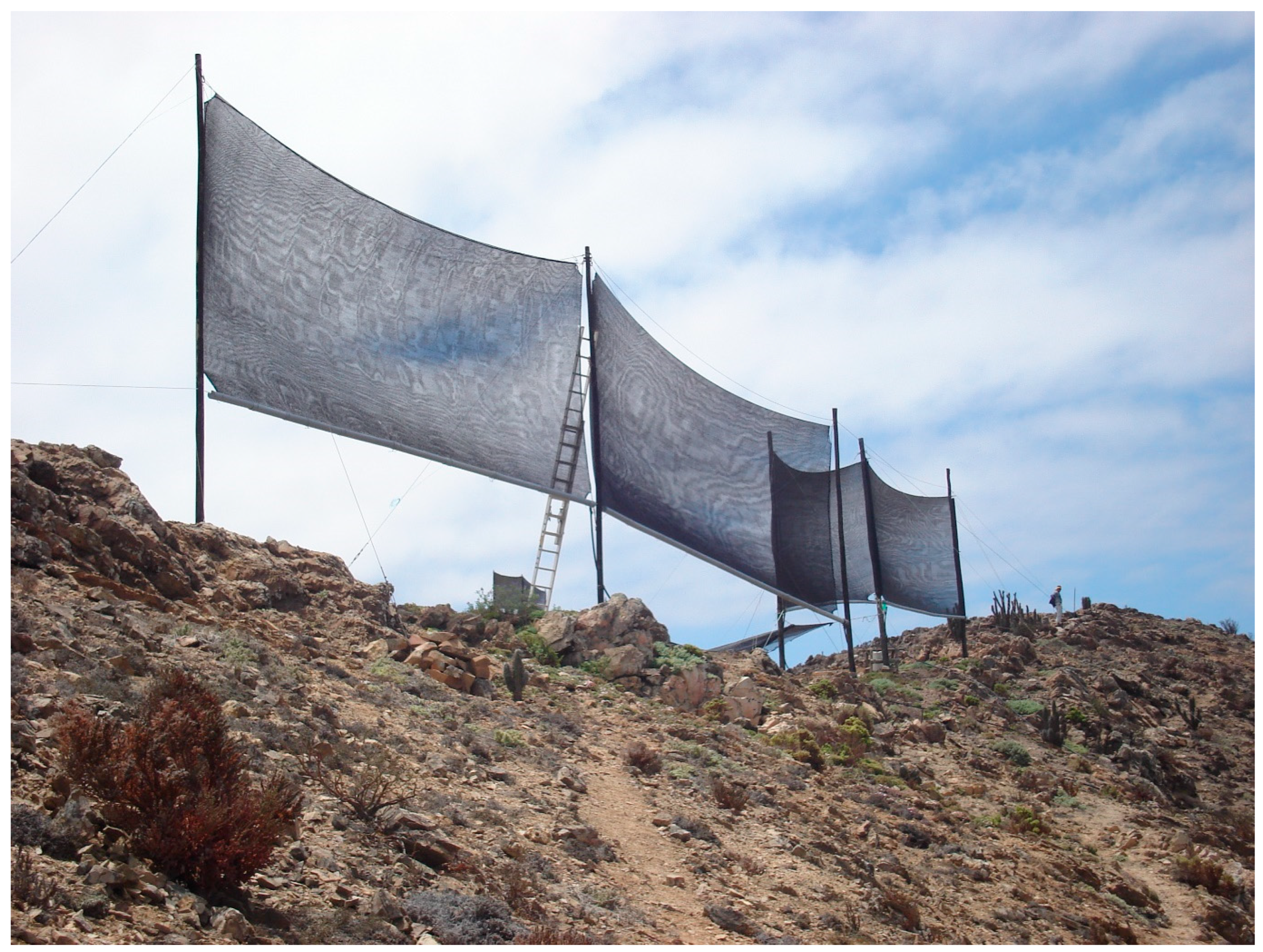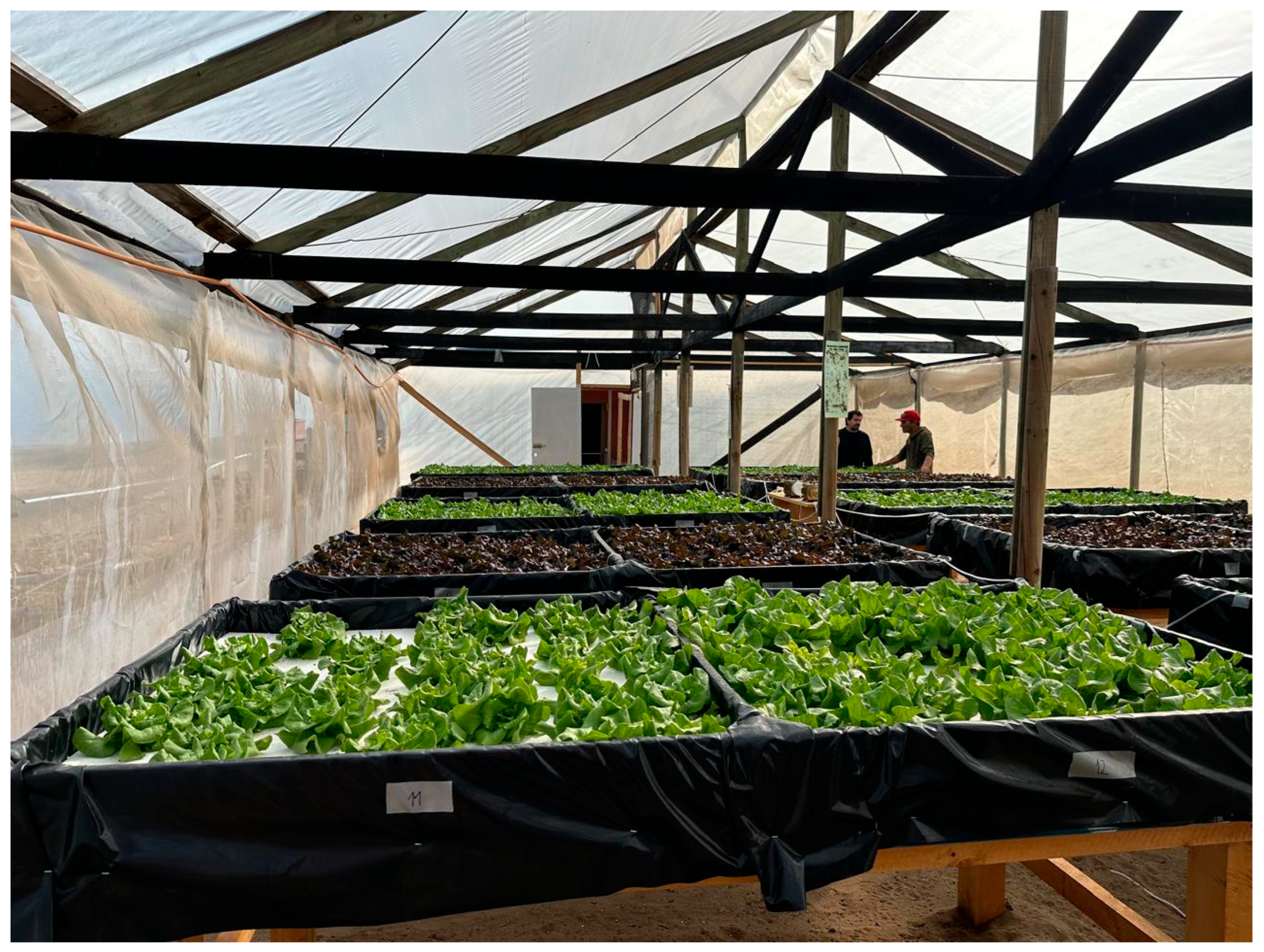Soilless Production of Lettuce (Lactuca sativa) in the Atacama Desert Using Fog Water: Water Quality and Produce Mineral Composition
Abstract
1. Introduction
2. Materials and Methods
3. Results
4. Discussion
5. Conclusions
Author Contributions
Funding
Data Availability Statement
Acknowledgments
Conflicts of Interest
References
- Albornoz, F.; del Río, C.; Carter, V.; Escobar, R.; Vásquez, L. Fog Water Collection for Local Greenhouse Vegetable Production in the Atacama Desert. Sustainability 2023, 15, 15720. [Google Scholar] [CrossRef]
- Sarricolea, P.; Meseguer, O.; Romero-Aravena, H. Precipitation Trends in the Chilean Norte Grande and its Relationship with Climate Change Projections. Diálogo Andino 2017, 54, 41–50. [Google Scholar] [CrossRef]
- Fussy, A.; Papenbrock, J. An Overview of Soil and Soilless Cultivation Techniques—Chances, Challenges and the Neglected Question of Sustainability. Plants 2022, 11, 1153. [Google Scholar] [CrossRef] [PubMed]
- Schwarz, D.; Grosch, R.; Gross, W.; Hoffmann-Hergarten, S. Water quality assessment of different reservoir types in relation to nutrient solution use in hydroponics. Agric. Water Manag. 2005, 71, 145–166. [Google Scholar] [CrossRef]
- del Río, C.; Lobos-Roco, F.; Latorre, C.; Koch, M.A.; García, J.; Osses, P.; Lambert, F.; Alfaro, F.; Siegmund, A. Spatial Distribution and Interannual Variability of Coastal Fog and Low Clouds Cover in the Hyperarid Atacama Desert and Implications for Past and Present Tillandsia landbeckii Ecosystems. Plant Syst. Evol. 2021, 307, 58. [Google Scholar] [CrossRef]
- Azeem, M.; Noman, M.T.; Wiener, J.; Petru, M.; Louda, P. Structural Design of Efficient Fog Collectors: A Review. Environ. Technol. Innov. 2020, 20, 101169. [Google Scholar] [CrossRef]
- Bonnail, E.; Cunha Lima, R.; Martínez Turrieta, G. Trapping fresh sea breeze in desert? Health status of Camanchaca, Atacama’s fog. Environ. Sci. Pollut. Res. 2018, 25, 18204–18212. [Google Scholar] [CrossRef] [PubMed]
- Mesías, S.; Martínez, L.; Yohannessen, K.; Alvarado, S.; Klarian, J.; Mateo, M.; Costilla, R.; Fuentes, M.; Caceres, D. Trace element contents in fine particulate matter (PM2.5) in urban school microenvironments near a contaminated beach with mine tailings, Chañaral, Chile. Environ. Geochem. Health 2018, 40, 1077–1091. [Google Scholar] [CrossRef]
- Hu, P.; Xu, S.; Xie, C.; Hu, S.; Cao, Y.; Zheng, F. Aerosol particles with NaCl-inlay in coastal haze-fog episodes. Air Qual. Atmos. Health 2021, 15, 59–71. [Google Scholar] [CrossRef]
- Xiao, H.W.; Xiao, H.Y.; Shen, C.Y.; Zhang, Z.Y.; Long, A.M. Chemical Composition and Sources of Marine Aerosol over the Western North Pacific Ocean in Winter. Atmosphere 2018, 9, 298. [Google Scholar] [CrossRef]
- Sun, J.; Jin, Z.; Chang, H.; Zhang, W. A review of chloride transport in concrete exposed to the marine atmosphere zone environment: Experiments and numerical models. J. Build. Eng. 2024, 84, 108591. [Google Scholar] [CrossRef]
- Shanyengana, E.S.; Henschel, J.R.; Seely, M.K.; Sanderson, R.D. Exploring Fog as a Supplementary Water Source in Nambia. Atmos. Res. 2002, 64, 251–259. [Google Scholar] [CrossRef]
- Albornoz, F.; Lieth, H. Daily Macronutrient Uptake Patterns in Relation to Plant Age in Hydroponic Lettuce. J. Plant Nutr. 2016, 39, 1357–1364. [Google Scholar] [CrossRef]
- Pincetti-Zuñiga, G.P.; Richards, L.A.; Daniele, L.; Boyce, A.J.; Polya, D.A. Hydrochemical Characterization, Spatial Distribution, and Geochemical Controls on Arsenic and Boron in Waters from Arid Arica and Parinacota, Northern Chile. Sci. Total Environ. 2022, 806, 150206. [Google Scholar] [CrossRef]
- Figueroa, L.; Tapia, L.; Bastias, E.; Escobar, H.; Torres, A. Levels of Boron in Irrigation Waters and Soils Cultivated with Olives in Northern Chile. Idesia 1994, 13, 63–68. [Google Scholar]
- Ayers, R.S.; Westcot, D.W. Water Quality for Agriculture; FAO Irrigation and Drainage Paper 29; Food and Agriculture Organization of the United Nations: Rome, Italy, 1994. [Google Scholar]
- Brdar-Jokanović, M. Boron Toxicity and Deficiency in Agricultural Plants. Int. J. Mol. Sci. 2020, 21, 1424. [Google Scholar] [CrossRef]
- Singleton, H.J. Copper Water Quality Guideline for the Protection of Wildlife, Livestock Watering and Irrigation; Water Quality Guideline Series, WQG-05; Ministry of Environment and Climate Change Strategy: Victoria, BC, Canada, 2019.
- Mensah, E.; Kyei-Baffour, N.; Ofori, E.; Obeng, G. Influence of Human Activities and Land Use on Heavy Metal Concentrations in Irrigated Vegetables in Ghana and Their Health Implications. In Appropriate Technologies for Environmental Protection in the Developing World; Yanful, E.K., Ed.; Springer: New York, NY, USA, 2009; pp. 9–14. [Google Scholar]
- FAO/WHO. Codex General Standard for Contaminants and Toxins in Food and Feed. Available online: https://www.fao.org/fileadmin/user_upload/livestockgov/documents/1_CXS_193e.pdf (accessed on 2 August 2024).
- Eckenfelder, M. Water Quality: Amient Water Quality Guidelines for Mercury; Ministry of Environment and Climate Change Strategy: Victoria, BC, Canada, 2001. Available online: https://www2.gov.bc.ca/assets/gov/environment/air-land-water/water/waterquality/water-quality-guidelines/approved-wqgs/bc_env_mercury_waterqualityguideline_overview.pdf (accessed on 2 August 2024).
- Xu, Z.; Peng, J.; Zhu, Z.; Yu, P.; Wang, M.; Huang, Z.; Huang, Y.; Li, Z. Screening of Leafy Vegetable Varieties with Low Lead and Cadmium Accumulation Based on Foliar Uptake. Life 2022, 12, 339. [Google Scholar] [CrossRef] [PubMed] [PubMed Central]
- He, L.; Wang, S.; Liu, M.; Chen, Z.; Xu, J.; Dong, Y. Transport and Transformation of Atmospheric Metals in Ecosystems: A Review. J. Hazard. Mater. Adv. 2023, 9, 100218. [Google Scholar] [CrossRef]
- Shandana; Khan, A.; Waqas, M.; Nawab, J.; Idress, M.; Kamran, M.; Khan, S. Total Arsenic Contamination in Soil, Vegetables, and Fruits and its Potential Health Risks in the Chitral Valley, Pakistan. Int. J. Sediment Res. 2024, 39, 257–265. [Google Scholar]
- China Food and Drug Administration. Standard for Maximum Levels of Contaminants in Foods. 2017. Available online: https://www.fsis.usda.gov/sites/default/files/media_file/2021-02/GB-2762-2017.pdf (accessed on 2 August 2024).
- Miller, A.; Langenhover, P.; Nemali, K. Maximizing Productivity of Greenhouse-Grown Hydroponic Lettuce during Winter. HortScience 2020, 55, 1963–1969. [Google Scholar] [CrossRef]
- Djidonou, D.; Leskovar, D.I. Seasonal Changes in Growth, Nitrogen Nutrition, and Yield of Hydroponic Lettuce. HortScience 2019, 54, 76–85. [Google Scholar] [CrossRef]


| Parameter | Units | Value | Recommended Maximum Value [8] |
|---|---|---|---|
| pH | 6.74 ± 0.54 | 6.5–8.4 | |
| EC | dS m−1 | 0.65 ± 0.18 | 0.7 |
| Calcium | mEq L−1 | 0.43 ± 0.07 | <20.0 * |
| Magnesium | mEq L−1 | 0.91 ± 0.30 | <5.0 * |
| Potassium | mEq L−1 | 0.08 ± 0.03 | <0.05 * |
| Sodium | mEq L−1 | 3.60 ± 1.10 | 3.0 |
| Chloride | mEq L−1 | 4.50 ± 1.30 | 3.0 |
| Sulphate | mEq L−1 | 0.72 ± 0.20 | <20.0 * |
| Bicarbonate | mEq L−1 | 0.28 ± 0.03 | 1.5 |
| Ammonium | mg L−1 | 1.80 ± 0.20 | <5.0 * |
| Nitrate | mg L−1 | 5.60 ± 0.90 | <10.0 * |
| Aluminum | mg L−1 | 0.12 ± 0.02 | 5.0 |
| Arsenic | mg L−1 | 0.04 ± 0.01 | 0.10 |
| Boron | mg L−1 | 0.15 ± 0.08 | 0.7 |
| Cadmium | mg L−1 | <0.01 | 0.01 |
| Copper | mg L−1 | 1.50 ± 0.08 | 0.20 |
| Iron | mg L−1 | 0.09 ± 0.05 | 5.0 |
| Manganese | mg L−1 | 0.04 ± 0.00 | 0.20 |
| Mercury | mg L−1 | <0.01 | 0.02 ** |
| Molybdenum | mg L−1 | <0.01 | 0.01 |
| Lead | mg L−1 | <0.01 | 5.0 |
| Zinc | mg L−1 | 0.01 | 2.0 |
| Nutrient | Green Leaf | Red Leaf |
|---|---|---|
| Nitrogen (%) | 3.03 ± 1.01 a | 3.25 ± 0.56 a |
| Phosphorus (%) | 0.50 ± 0.04 a | 0.45 ± 0.01 a |
| Potassium (%) | 1.41 ± 0.09 b | 2.08 ± 0.29 a |
| Calcium (%) | 0.49 ± 0.02 a | 0.36 ± 0.03 b |
| Magnesium (%) | 0.27 ± 0.01 a | 0.26 ± 0.01 a |
| Sulfur (%) | 0.08 ± 0.00 a | 0.08 ± 0.00 a |
| Chloride (%) | 3.33 ± 0.14 a | 2.83 ± 0.56 a |
| Sodium (%) | 1.05 ± 0.23 a | 0.96 ± 0.02 a |
| Iron (mg kg−1 DW) | 129 ± 27 a | 137 ± 33 a |
| Boron (mg kg−1 DW) | 29 ± 7 a | 44 ± 12 a |
| Manganese (mg kg−1 DW) | 79 ± 48 a | 76 ± 43 a |
| Molybdenum (mg kg−1 DW) | 0.21 ± 0.06 a | 0.15 ± 0.02 a |
| Heavy Metal | Mineral Content (mg kg−1 DW) | |
|---|---|---|
| Green Leaf | Red Leaf | |
| Zinc | 49 ± 23 a | 49 ± 24 a |
| Copper | 43 ± 24 a | 27 ± 7 a |
| Arsenic | 0.40 ± 0.00 a | 0.44 ± 0.03 a |
| Cadmium | 0.10 ± 0.00 a | 0.10 ± 0.01 a |
| Mercury | 0.02 ± 0.00 a | 0.02 ± 0.00 a |
| Lead | 0.47 ± 0.02 a | 0.31 ± 0.01 b |
Disclaimer/Publisher’s Note: The statements, opinions and data contained in all publications are solely those of the individual author(s) and contributor(s) and not of MDPI and/or the editor(s). MDPI and/or the editor(s) disclaim responsibility for any injury to people or property resulting from any ideas, methods, instructions or products referred to in the content. |
© 2024 by the authors. Licensee MDPI, Basel, Switzerland. This article is an open access article distributed under the terms and conditions of the Creative Commons Attribution (CC BY) license (https://creativecommons.org/licenses/by/4.0/).
Share and Cite
Albornoz, F.; Vilches, I.; del Río, C.; Carter, V. Soilless Production of Lettuce (Lactuca sativa) in the Atacama Desert Using Fog Water: Water Quality and Produce Mineral Composition. Horticulturae 2024, 10, 957. https://doi.org/10.3390/horticulturae10090957
Albornoz F, Vilches I, del Río C, Carter V. Soilless Production of Lettuce (Lactuca sativa) in the Atacama Desert Using Fog Water: Water Quality and Produce Mineral Composition. Horticulturae. 2024; 10(9):957. https://doi.org/10.3390/horticulturae10090957
Chicago/Turabian StyleAlbornoz, Francisco, Inés Vilches, Camilo del Río, and Virginia Carter. 2024. "Soilless Production of Lettuce (Lactuca sativa) in the Atacama Desert Using Fog Water: Water Quality and Produce Mineral Composition" Horticulturae 10, no. 9: 957. https://doi.org/10.3390/horticulturae10090957
APA StyleAlbornoz, F., Vilches, I., del Río, C., & Carter, V. (2024). Soilless Production of Lettuce (Lactuca sativa) in the Atacama Desert Using Fog Water: Water Quality and Produce Mineral Composition. Horticulturae, 10(9), 957. https://doi.org/10.3390/horticulturae10090957






